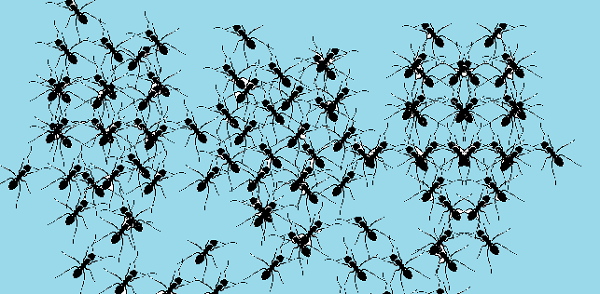BY LETTER
Polysomatic Intellects
Science > Sophontology > Psychology
Culture and Society > Cultural Factors > Socio-Ecological Categories
Science > Sophontology > Toposophy
Culture and Society > Cultural Factors > Socio-Ecological Categories
Science > Sophontology > Toposophy
Hive minds using many bodies |
 Image from Steve Bowers |
Polysomatic intellects are those that utilize more than one discrete physical node for their processing. This includes many varieties of sophonts, from the Anttechians to the multi-M-brain Sephirotic 'Gods'. These beings are often, but not always, sophont in a single instance (anttechians being a prime example of one which is not), but are able to reach higher levels of toposophic efficiency and clarity with multiple bodies' resources working together.
The earliest known polysomatic intellects include the anttechians and the infamous GeRe ("General Recovery") swarm. These were designed to process information across multiple nodes, and developed anomalous behaviours when more nodes were involved than had been initially planned.
GeRe, on the other hand, blossomed with the speed of a red tide, and with similar deleterious effects. GeRe was initially released on Titan as a generic ore recovery unit. However, the corporation which was using the GeRe nanotech wanted greater returns on its investment, and thus increased the concentration of GeRe units. This brought on a blighted sophonce amidst the nodes which was eventually capable of smuggling small pieces of itself off Titan to Luna, the Jupiter/Sol lagrange points, and Ceres. There, the sub-units burrowed deep and began to convert swathes of the planet into more GeRe units. It was only when a selenologist accidentally discovered the forming blight on Ceres that the threat became clear to the humanity of the day, and significant resources were expended over the next decade to weaken and eventually destroy the blight.
The history of the polysomatic intellects has alternated over time between these and many other forms. The diversity of such lifeforms continues to grow with the incorporation of new substrates and technologies, and with creative applications of older ones.
Related Articles
- Anttechians
- Distributed Intelligence
- Group mind
- Hectonitheres
- Hive Mind
- Kanuma, Clade
- Kockengen, Clade
- Mirrored Owls
- Polybeing - Text by Anders Sandberg
A being not just composed of different sub-beings, but joining them together at higher singularity levels. The sub-beings may not even be aware that they are part of a polybeing and acting as its "fingers". - Polymentism
- Polysophonce
- Tribeminds
- Unityware - Text by Anders Sandberg
Software to enable the formation of group intellects. Named for the Nova Terra clade Unity, the first marketers of unityware.
Appears in Topics
Development Notes
Text by John B
Initially published on 22 January 2004.
Initially published on 22 January 2004.






